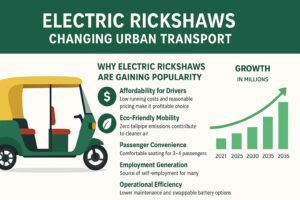The transformation of urban transport in India is being powered by innovation, sustainability, and the need for affordable mobility solutions. At the heart of this change lies the rise of electric rickshaws (E-rickshaws), a revolution in last-mile connectivity and shared urban transport. Offering a clean, economical, and practical alternative to conventional auto-rickshaws and cycle rickshaws, E-rickshaws are not just vehicles—they represent a shift towards smarter and greener cities.
The Rise of Electric Rickshaws
Over the last decade, E-rickshaws have become an increasingly common sight on Indian roads, particularly in tier-2 and tier-3 cities. Their popularity stems from affordability, simplicity of operation, and their ability to provide seamless short-distance travel. Unlike traditional cycle rickshaws that rely on manual labor or auto-rickshaws that depend on costly and polluting fossil fuels, E-rickshaws operate on rechargeable batteries, making them both economically viable and environmentally friendly.
Government policies, such as the FAME (Faster Adoption and Manufacturing of Electric Vehicles) scheme, state-level incentives, and relaxed licensing norms, have further accelerated the adoption of E-rickshaws. Today, they form a significant part of India’s growing electric mobility ecosystem, with millions already on the road and many more expected to be deployed in the coming years.
Why Electric Rickshaws Are Gaining Popularity
-
Affordability for Drivers
E-rickshaws are relatively inexpensive compared to auto-rickshaws and offer low running costs. Drivers can save on fuel expenses as electricity is far cheaper than petrol, diesel, or CNG. This makes them a profitable choice for livelihood, especially in small towns and rural-urban transition areas. -
Eco-Friendly Mobility
Traditional fossil-fuel rickshaws emit harmful gases, contributing to air pollution and greenhouse gas emissions. E-rickshaws, on the other hand, produce zero tailpipe emissions, making them an effective tool in reducing urban pollution and supporting India’s clean energy goals. -
Passenger Convenience
E-rickshaws offer comfortable seating for three to four passengers, providing safe and smooth rides without the noise and vibrations associated with fuel-based engines. Their compact design makes them ideal for navigating congested city roads and narrow lanes. -
Employment Generation
With minimal training required, E-rickshaws have emerged as a source of self-employment for thousands of people. Drivers with limited educational qualifications or resources can easily own or rent an E-rickshaw, securing a stable income. -
Operational Efficiency
Battery-powered E-rickshaws are cost-efficient, requiring less maintenance compared to vehicles with complex engines. Many models now come with swappable battery technology, reducing downtime and allowing drivers to stay on the road longer.
Challenges Facing the E-Rickshaw Sector
While the benefits are undeniable, the growth of E-rickshaws is not without challenges.
-
Battery Limitations: Many E-rickshaws still use lead-acid batteries, which have shorter lifespans and require frequent replacements. Although lithium-ion batteries are emerging as a better alternative, their high upfront cost remains a barrier.
-
Charging Infrastructure: In many towns and cities, proper charging stations are still limited. Drivers often rely on domestic connections to charge their vehicles, which can be time-consuming and inefficient.
-
Unregulated Market: The rapid, sometimes unplanned, expansion of E-rickshaws has led to challenges in safety standards, road discipline, and regulation. Ensuring the vehicles are compliant with safety norms is critical for passenger and driver security.
-
Range Anxiety: Most E-rickshaws offer a range of 80–120 kilometers on a full charge, which is sufficient for daily use but still restricts longer operations or multiple shifts in a single day.
Impact on Urban Transport
The arrival of E-rickshaws has reshaped last-mile connectivity in Indian cities. They bridge the gap between major transport hubs such as metro stations, bus stops, and railway stations to final destinations like markets, offices, and residential areas. By doing so, they reduce dependence on personal vehicles, easing urban congestion and supporting public transport systems.
Furthermore, E-rickshaws are becoming a crucial part of shared mobility solutions. In many cities, they are integrated with app-based ride-hailing services, allowing passengers to book rides conveniently. This hybrid model enhances accessibility and brings structure to the informal transport sector.
The Road Ahead
The future of E-rickshaws in India looks promising. With technological advancements, the shift to lithium-ion batteries, and the expansion of charging infrastructure, operational efficiency will improve dramatically. Government-backed financing schemes and subsidies will also make E-rickshaws more affordable for drivers, accelerating adoption.
Additionally, as smart city initiatives gain momentum, E-rickshaws are expected to play a vital role in sustainable urban planning. Integration with renewable energy sources like solar charging stations will further enhance their eco-friendly appeal.


